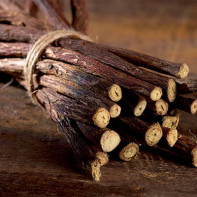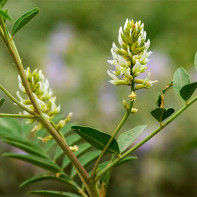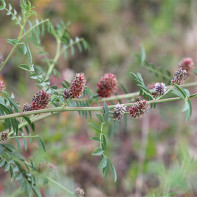Licorice: therapeutic properties and contraindications
This article provides information about licorice and its healing root, its multifunctional use in medicine and cosmetology.
- Chemical composition
- How it looks and where it grows
- Types
- Gathering and storage
- Therapeutic properties of licorice root
- For Women
- For Men
- In pregnancy
- When breastfeeding
- For children
- When losing weight
- Licorice in medicine
- Diabetes mellitus
- In pancreatitis
- For gastritis
- For bowel
- For constipation
- For the lymphatic system
- For the liver
- For hemorrhoids
- For coughs
- For bronchitis
- Skin diseases
- Types of medicinal compositions with licorice
- Infusion
- Infusion
- Decoction
- Tea
- Powder
- Sherbet Cream
- Cosmetic applications
- How to take licorice syrup with a cough
- Contraindications for use
Chemical Composition
Licorice root - a real treasure trove of useful and healing substances, such as asparagine, ascorbic, glycyrrhetinic free, glycyrrhizic acid and glycyrrhizin. Also present in the composition are sterols, coumarins, triterpene saponins and many flavonoids, various chemical elements (aluminum, selenium, potassium, chromium, calcium, copper, manganese, zinc, magnesium, iron, etc.).
The above-ground part of the plant contains tannins, essential oils, flavonoids, pigments, saponins and polysaccharides.
What it looks like and where it grows
All species of licorice (sweet root, licorice, juniper, glandular licorice) are perennial herbaceous powerful plants. Their stems are strong, thick, erect, and can reach a height of 0.5 to 1 m. The root system consists of the main root, which goes deep into the ground for nearly 8 m, and branched lateral horizontal roots that extend up to 5 m. They provide the plant with a good supply of moisture and nutrients.
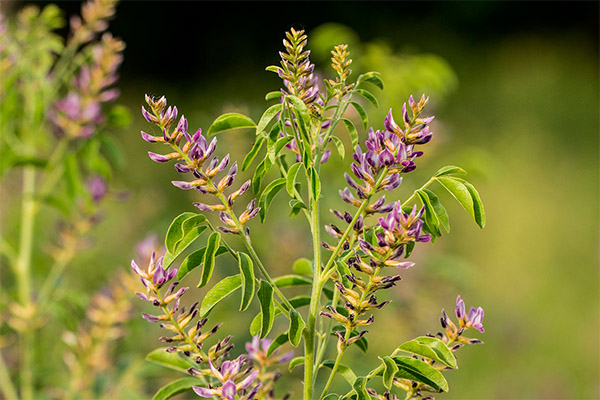
Due to the growth buds located in the root zone, licorice can greatly proliferate and turn into strong thickets, which is perceived as weed growth. The leaves are arranged alternately, resembling eucalyptus leaves in shape. There are many glands on their back surface. The leaf plate is shiny and slightly sticky. Depending on the species, there are both twisted at the end and wavy leaves. The inflorescences have the form of loose pyramid-like brushlets. They emerge from the axils of the upper leaves.
Flowers vary in color from pale purple to purple-white, depending on the species. The fruit is a bean, weakly or strongly curved, leathery, brown in color.
Licorice is unpretentious and grows on different types of soil: sandy, loamy, chernozem. It feels well in the steppes and semi-steppes, on fields and river banks, but does not like the close location of groundwater to the soil surface and strong winds. Depending on the species licorice grows in the territory of the Caucasus, south and east Europe, east and west Siberia, south of the Urals, on the shores of the Azov Sea, the Volga and the Don, in the Crimea, Kyrgyzstan and Kazakhstan.
Types
Licorice is divided into the following species: naked and Ural. Distinctive features are the area of growth and differences in appearance. Naked licorice has leaves that are curled down at the ends, and the flowers have a lighter coloring. Uralskaya has leaves, strongly undulated at the edges, and denser inflorescences. It has a bitter taste.
Gathering and storage
The healing roots of licorice are collected in the first month of spring and in late fall, just before frost. They are dug out, but more than 75% of the base, to give the plant the opportunity to recover. The age of the bush should not be less than 3-4 years. The next harvesting in the same place can be carried out only in 6 years. The extracted roots are shaken off the soil, thoroughly washed with running water and sorted out, removing the damaged ones. Then they are cleaned of bark, then cut into small cuttings 30 to 35 cm long and dried well in the sun or in a drying chamber at a temperature not exceeding 60 degrees. Ready dried roots have a yellowish color.
Harvests are stored for 10 years. If it is necessary to make juice from the roots, they are boiled, placed in a vacuum chamber and pressed into pharmacological forms.
Therapeutic properties of licorice root
Licorice with its therapeutic properties is known for more than five thousand years. It originated in China and Tibet, where it was used along with the most popular ginseng. The more preferable use was given to prescribing licorice root for young children and older people, because of the excellent indications for strengthening the body and rejuvenating effect. According to records in the medical encyclopedia of ancient Egypt, drugs containing licorice root were used as an anti-inflammatory and restorative.

It was later used in France, too. It was used in the treatment of diseases of the gastrointestinal tract, bronchitis, dry chest cough, as well as in inflammatory processes. And the Russian professor A.V. Mozheiko proved the excellent effectiveness of licorice root in the treatment of inflammatory processes of the respiratory system. Preparations based on licorice root have found widespread use in pediatrics as a medicine, the side effects of which are not nausea and vomiting. Having thoroughly studied all the properties of this plant, Japanese scientists have already isolated a substance that can suppress the cells of the AIDS virus.
Antisclerotic effect on the human body is due to the presence of glycyrrhizic acid in licorice. It is it, reacting chemically with elements of cholesterol, slows its formation, behaves as an anti-allergic and anti-inflammatory agent, very well influence the work of the adrenal glands. Saponins (foaming substances in common parlance) increase the secretion of the mucosa of the gastrointestinal tract and respiratory system, prevent their irritation and exposure to harmful components of food and aggressive medicines. They help to quickly liquefy phlegm that has collected in the respiratory tract, facilitate expectoration, and disinfect.
The flavonoids in licorice provide an analgesic function to relieve the discomfort of spasms and inflammation, also being a laxative for the smooth muscles of the intestines. They take part in the normalization of the permeability of blood vessel walls.
For women.
As a wound-healing and rapidly restorative agent, licorice root is actively used in the treatment of gynecological diseases, inflammatory processes, cervical erosion. It also helps in the treatment of thyroid disorders, gastric and duodenal ulcers, gastritis, is necessary for the normalization of metabolism and acidity levels in the body, eliminating intestinal and genitourinary problems, helps improve blood pressure.
The plant has proved excellent in the treatment of complex skin diseases such as allergic dermatitis, seborrhea, psoriasis, eczema, acne, lupus, neurodermatitis, vesicular disease and others.
Otolaryngologists often use in their practice preparations that include licorice root for problems of the mouth, nasal mucosa and ears.
Licorice is used as a component that increases the body's production of its own insulin, which helps the pancreas in patients with type 2 diabetes. Licorice root is known for its ability to neutralize many kinds of poison of natural origin since ancient times. It was later, with the advent of cancer, licorice also began to be used because of its ability to inhibit the growth of cancer cells. A greater effect was obtained after chemotherapy.
If you regularly consume dried apples with licorice, then premenstrual syndrome will not be so painful, the metabolism is normalized. During the menopausal period and mastopathy, the drug with licorice is necessary for women both for prevention and for effective treatment. Modern scientists have confirmed the effectiveness of the use of licorice as a contraceptive by ancient people. This is due to the strong estrogenic property of the root.
For men
Also drugs containing licorice are used by traumatologists, surgeons and urologists and proctologists. On a par with ginseng in the East also use licorice root tea to increase the vitality of men, immunity and the body's resistance to the harmful environment. As a powerful antidepressant, this plant increases the tone of a chronically tired body. The Japanese use licorice as a dietary supplement to make people quit smoking.
In urology, medicines that include licorice root are widely used in getting rid of prostate adenoma disease, kidney and urinary tract pathologies. In disorders of the joints, osteochondrosis, rheumatism, arthritis, as well as the presence of intervertebral hernia are prescribed drugs with licorice. It has long been believed that in order to help a person after a hangover, he should be given a small piece of licorice root to chew on.
When pregnant
Pregnant women, as well as children under the age of three, the reception of licorice in any form is contraindicated. This is due to its ability to affect the water-salt balance of the body. That is, when using it, pregnant women may have edema. Their constant presence can lead to the development of a serious complication - gestosis. This is a significant reason for refusing to use drugs containing licorice. Otherwise, neglecting this warning is fraught not only with the threat of death of the unborn child, but also of the mother herself. The next reason for the inadmissibility of the use of licorice or its root is the property of them to cause a sharp fluctuation in hormonal background in the body, and this can lead to a threat of miscarriage.
When breastfeeding
After the birth of the baby, young mothers in 2-3 months can already take medicines that include licorice or its root, but necessarily after prescribing them by the doctor. Having the property of thinning blood, such drugs can provoke uterine bleeding. If the composition also contains ethyl alcohol, then at the time of its use should be completely renounced from breastfeeding, because it has a negative effect on the newborn baby.
For women themselves during lactation licorice preparations are useful. They restore hormonal background, normalize water-salt balance, put the CNS in order, improve sleep, help cope with colds and viral infections, eliminate inflammation of the urogenital system, help strengthen blood vessels, improve liver and gallbladder, together with other medicines fight worm infestation. The body of nursing mothers increases immunity, which ensures its resistance to external bacteria. But be sure to remember that before using medicines with licorice, it is imperative to consult with your doctor and strictly follow his recommendations and doses.
For children
When children are sick, it is always unpleasant, but there is no way to avoid it. Sometimes it is also useful to develop immunity.
For children, the use of medicines containing licorice or its root is recommended for both prevention and treatment:
- chronic fatigue;
- Pathologies of the mouth, nose, and upper respiratory tract;
- acute respiratory diseases;
- hyperexcitability;
- rapid fatigue;
- removal of toxins and germs, stimulating vitality.
Small children, the first use of drugs containing licorice or its root is recommended very carefully to avoid any complications. Until a year of age, in general, the use of these drugs is contraindicated.
Before you appoint a year-old baby licorice, first conduct a procedure to determine the reaction to such a drug. If he has no individual intolerance to the components of the drug, it is appointed with caution and in small doses. If the child has an allergic reaction, it should in no case be used. Be sure to show the child a doctor before using licorice and adhere to the recommendations.
Since this plant affects the adrenal glands, unwanted side effects may occur. If the child was prescribed a drug with licorice, the duration of its use - a maximum of ten days, and the dosage should not exceed that prescribed by the doctor.
The licorice plant is one of those whose use in small doses and at short intervals is beneficial, but in large doses and prolonged use brings only harm. An example is the effect of licorice root on boys and men. It is known that licorice affects the production of the male hormone testosterone, so the long-term use of drugs with this plant or its root can lead to hormonal imbalance in the growing body. But the correct use of medication, on the contrary, will put in order the hormonal background and will even contribute to the improvement of potency in men.
When losing weight
As you know, people gain extra weight for many reasons, some of which are disorders of the gastrointestinal tract and diseases of the endocrine system. Licorice and its root have the property of normalizing these organs by healing wounds, protecting the mucous membranes, removing toxins from the body, lowering the level of acidity, if it is high, eliminating heartburn, suppressing the feeling of nausea, normalizing stools. Therefore, they ensure that the weight is brought back to normal.
Licorice in medicine
Because of its useful and therapeutic properties, licorice and its root have firmly entered the modern sphere of medicine and has been officially recognized. On the basis of this plant was created a lot of drugs, tinctures, syrups a wide range of action and age application. The effectiveness of licorice, due to its properties, is not inferior to many long-known drugs. But the advantages of licorice-based preparations lie in their naturalness. They are not chemically derived and are not synthetic.
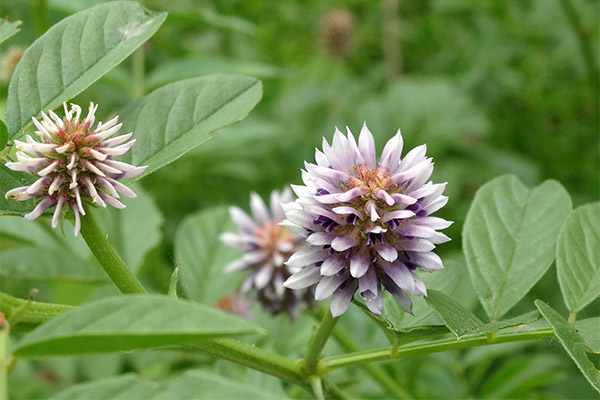
With diabetes
Decoction for the disease of diabetes is prepared as follows: to 1 tsp. with a handful of crushed licorice root add 200 ml of boiling water and simmer in a steam bath for half an hour. Strain, let cool slightly, and use one-third cup before a meal for half an hour during the day. At night you should drink the decoction already after a meal after 2 hours.
With pancreatitis
To replenish the pancreas with the necessary enzymes, you should use an infusion of equal amounts of crushed licorice root, dandelion and burdock. Take the ingredients in 5 grams of each. Add 500 ml of boiling water and allow to stand. Strain and drink hot 100 ml 2-3 times a day.
With gastritis
Licorice juice is used to treat gastritis. To get it, you need to use only the fresh root. Wash it thoroughly, peel and grate it on a fine grater, then squeeze the resulting mass well through gauze or bandage. Then take 10 drops with a dropper and dissolve in 100 ml of boiling water. Cool to a warm temperature and take four times a day, 1 tbsp. before eating. The course of treatment to continue for 14 days.
With peptic ulcer and gastritis use decoction of licorice. Take about 10 grams of mashed licorice root, add a glass of boiling water and steam steaming for 20 minutes. Then strain and steep to infuse for 2 hours. Use at least 5 times a day.
When the disease ulcers, arthritis and tumors used licorice tincture. For its preparation 2 tsp. grinded licorice roots should be roasted in a pan, then add 400 ml of boiling water. Wrap and insist about 8 hours. At the end of this time, the tincture will be ready for use. Take 35-40 drops.
For the intestines
If you have pain in the intestines, you can use this recipe: take licorice, chamomile and lemon balm in proportions of 2:1:1 and brewed as a tea. Use 1 cup an hour after a meal.
With constipation
An infusion of licorice root (4 tbsp.), fennel (2 tbsp.), anise (2 tbsp.) and grits bark (8 tbsp.) can relieve constipation. Take 3 tbsp. of this collection and add 100 ml of boiling water. Wrap and infuse for half an hour. Give children in violation of the gastrointestinal tract for normalization of digestion and stool for 10 days, 50 ml three times a day for half an hour before eating.
You can also use licorice powder mixed with honey to improve the gastrointestinal tract. It is given to children before meals.
A good laxative effect gives the following recipe. Need 1 tbsp. finely mashed licorice root pour 2.5 cups of warm water and simmer over low heat for 10 minutes. Then let cool and strain through a bandage, squeeze the rest. Use 30 grams before the next meal for no more than 10 days. Otherwise, there may be side effects, such as difficulty exiting fluids from the body, decreased libido, increased blood pressure.
For the lymphatic system.
When a person's lymphatic system malfunctions, a very unpleasant disease - lymphotoxicosis - can occur, which leads to excessive strain on the most important internal organs: kidneys, liver, intestines. In the long course of lymphotoxicosis eventually awaits a disappointing diagnosis in the form of hepatitis, dysbacteriosis, colitis, etc. It can end with bile stagnation in the body, slowing the output of metabolic products, intestinal dysfunction (constipation), frequent inflammation of the urogenital system (cystitis), which is indicated by external signs in the form of psoriasis, dermatitis and other skin rashes. To avoid this, you can take licorice root as a prophylactic. This is very easy to do by taking 1 tbsp of syrup and diluting it in a glass of hot water. Drink the entire contents of the glass on an empty stomach. The cleansing of the body can come in an hour.
For the liver
To avoid cirrhosis or liver cancer, people with hepatitis C must take licorice root extract. This is a drug that is taken undiluted 3-4 times a day. It should be drunk with plenty of water.
When hemorrhoids
Decoction can be prepared as follows: pour 1 tbsp. mashed licorice root with 250 ml of steep boiling water and simmer over low heat for half an hour. Allow to cool, strain and bring by adding lukewarm water to the initial amount. The drink to drink warm 0.5 cup before a meal (half an hour) 3-4 times a day.
From coughs
- 1 tbsp. dried licorice roots should be poured into a bowl of enameled steel and add 1 cup of water. Then, covered tightly with a lid, put the brew on a steam bath for 20 minutes. Then let the infusion cool to room temperature for about an hour, then strain and squeeze the rest. The resulting solution to bring the initial amount by pouring warm boiled water. Keep such an infusion no more than two days in the refrigerator. It should be used 3 or 4 times a day by 1 tbsp. After the course of treatment the patient's sputum will become liquid and come out, and the cough will subside.
- The infusion is not as concentrated as the decoction, so you can not store it, unlike the previous one. To prepare the infusion, take 1 tbsp. mashed root and pour a glass of boiling water. Wrap the infusion in something warm and leave to infuse for one hour. Also for this procedure will be great thermos. Then the infusion should be strained and well squeeze the rest. It is used by both children and adults. Children under 12 years old can drink from 1 to 2 tsp. 2-3 times a day, and older children and adults - from 1 to 2 tablespoons 3-4 times a day before a meal for half an hour.
- When viral diseases drink tea from a collection of the following herbs: licorice, St. John's wort, lemon balm and mint. The presence of yarrow in this collection increases the effect of licorice in relation to the removal of inflammation, strengthen immunity and restore vitality. Such a mixture can be purchased in a pharmacy or made yourself. To do this, take finely chopped or ground herb licorice and other ingredients in the proportion of 3 to 1 (that is, 3 tsp. licorice and 1 tsp. each of goldenseal, melissa and mint). Take 1 tsp. of the resulting collection, pour it steep boiling water and put in a warm place. Insist about 15 minutes. Then strain and squeeze out the rest. Give children after a meal 50 ml for 7-10 days.
- Infusion of coughs consists of 3 components: licorice, marshmallow and elecampane. Need to take 3 tsp. Collection and place in a glass container. Add 2 cups (400 ml) of boiled water at room temperature and infuse for 7-8 hours, put in a light-proof place. Children to give 50 ml twice a day before a meal for up to 10 days, no more.
- Tea against coughs is made from licorice root and Icelandic moss in a ratio of 2:1 with the addition of rose hips and plantain leaves. It should be brewed as usual tea and consumed throughout the day.
- Tincture for colds should be prepared by making a preliminary collection of equal parts of licorice root, thyme and marshmallow root. Mix everything until homogeneous and set aside 1 tbsp. of the mixture in a heatproof container. Add to the contents of a glass of boiling water and simmer over low heat for about 5 minutes. Then leave to infuse for 2 hours. It is better to use with honey. Children's dosage - 1-2 tbsp, adults - a third cup 3 times a day before a meal.
With bronchitis
Decoction for bronchitis can be made by mixing the following components: licorice, mother-oil, fennel and marshmallow. Thoroughly mix the herbs taken in the following amounts: licorice roots - 3 tablespoons, mother-and-oil - 2.5 tablespoons, fennel fruits - 2 tablespoons and marshmallow - 4 tablespoons. take 4 tbsp. of the mixture and pour into a container. Add 400 ml of steep boiling water. Soak in a water bath with a tight lid for 15 minutes. Allow to cool to room temperature and strain. Squeeze out the rest. Give children 50 ml four times a day for half an hour before a meal.
You can use a collection of the following herbs, taken in equal amounts: licorice root, mother-oil, violet, plantain leaves.
Even with a cough, you can use licorice root powder, mixing 1 tsp of the preparation with 1 tsp of vegetable oil and the same amount of honey. Then mash it all with a medium-sized potato, boiled in jacket. From the resulting mass mold a flatbread and place it on the child's chest. Keep for half an hour.
Infusion in the treatment of asthma and bronchitis should be prepared as follows: 1 tbsp. mashed licorice root combine with 1 cup boiling water and simmer over low heat for about 10 minutes. Wrap and infuse for an hour. Then strain and use 1 tbsp. four times a day.
For skin diseases
With allergic rashes, dermatitis, as well as eczema, you should make lotions of licorice root. It is prepared as follows: Take the powder of licorice root and combine it with steep boiling water in a ratio of 1:10. Thermos with the infusion to leave overnight, then strain and well-moistened in it a cotton pad put on the damaged skin for an hour 1 to 3 times a day.
Types of medicinal compositions with licorice
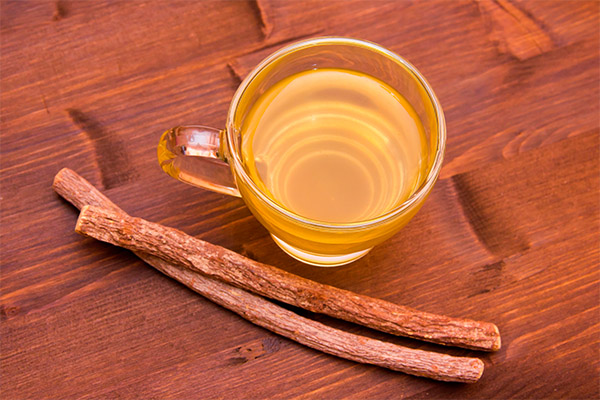
Infusion
- Add 200 ml of hot boiling water to 1 teaspoon of mashed licorice root and infuse for 1-2 hours. Cool and strain. Apply 1 tbsp. Three times a day before meals.
- 2 tablespoons of dried plant pour 500 ml of steep boiling water and infuse for a couple of hours. Cool and strain. Take 100 ml twice a day before meals.
Tincture .
Licorice alcohol tinctures are recommended as a dietary supplement - 25 to 55 drops diluted with a small amount of water, three times a day.
Decoction
For general strengthening of the body and increasing vitality, you can use a decoction of the following ingredients: licorice, pine needles and onion husks. It does not taste very pleasant, but very effective drink. Its preparation will require a tbsp. grinded onion husks, 1 tsp. grinded licorice roots and 50 grams of any needles (pine or fir). In addition we will need 1 tbsp. purified from the seeds of rose hips. The mixture of husks, licorice and pine needles pour 2 liters of boiling water and place on a small fire to simmer. This procedure takes about 10 minutes. Then add rosehip and leave it for a few more minutes.
The resulting decoction put in a thermos and leave to insist for half a day (12 hours). After that, strain the broth and bring it to a boil again. Give children 0.25 cup before meals for 10 days.
Tea
Tea is the weakest concentrated drink made from licorice. It can be prepared either from a single ingredient or by adding various spices, such as melissa, lemon, mint, etc. The advantage of this tea is that, thanks to the glycyrrhizin in the licorice root, which is a substitute for sugar, the latter does not need to be added to it.
If making tea from dry raw materials, you need to take 1 tsp. herb, pour it a glass of boiling water, add (if desired and to taste) spices and let stand for about 15 minutes. Then pour it into cups by two-thirds and add hot water.
You can also buy bagged tea. Then it is brewed in the usual way (one sachet per cup).
Children can drink tea from licorice, but no more than 2 times a week, one cup. Such a drink helps to strengthen the immune system.
Licorice is also part of other medicinal teas. Other components to it are ginger, anise, lime, etc. Such blends are available in great variety in pharmacies and stores.
Powder
You can use licorice root powder in the following way to increase performance and vitality. Mix 12 tsp. of the powder with 1 tsp. of honey and take three times a day.
Sherbet cream
To prepare such a useful treat, you need to mix 300 g of apple puree with 50 g of lemon juice. Whip two egg whites with a blender and gently introduce them into the prepared mass. Then put the cream in the freezer for 2.5-3 hours. Before treating guests, add licorice root powder to the cooled apple mass, mix gently and spread the cream on the sherbet.
Its cosmetic uses
Licorice and its root have become widely used in cosmetology because of the properties of this plant to influence the water-salt balance of the body, and therefore the skin. Cosmetic products using licorice in the first positions can eliminate inflammation, fight germs and viruses, irritated skin, relieve swelling and prevent the appearance of age spots. Due to the naturalness of such cosmetics, they are in great demand both in cosmetic salons and by women at home.

Because of all the listed properties of licorice, skin care products have a mild cleansing effect. The restorative properties of licorice root have led to its use in a large number of anti-aging products. Creams with its participation prevent the appearance of wrinkles, remove pigment spots and freckles, bleach the skin.
The variety of useful and medicinal properties allows licorice to be a universal component of various cosmetic products: lotions (for different types of skin), balms, shampoos, rinses, conditioners, creams, masks, tonics, etc. When caring for your scalp and hair, using products with licorice root, provides the necessary level of hydration of the scalp, there is no flaking and itching. Hair becomes shiny, silky, gets a beautiful color.
Some very simple home recipes for cosmetics are listed below.
- Hair rinse. To 1 tbsp. grinded licorice root should be added 1 liter of boiling water and simmer over low heat in a steam bath for half an hour. Then allow to cool to a warm temperature, strain and apply.
- Hair rinse. To a small handful of crushed licorice add 1 liter of warm water and 1 tbsp. fruit vinegar. Infuse for 15 minutes and apply.
- Masks for sensitive skin use licorice root powder effectively. It is combined with banana or milk.
- To remove freckles and age spots, a fresh infusion of licorice is used. To prepare it, you should take 1 tbsp. crushed licorice root, pour a glass of boiling water and infuse to the desired temperature. Soaked in this infusion absorbent cotton is good to wipe your face and neck.
- To increase tone and improve the appearance, it is effective to apply compresses with licorice. To do this, you need to take an infusion of a pleasant temperature, dip a flap of cloth in it and put it on your face.
- To maintain healthy facial skin, you can conduct daily washing with decoction of licorice. In just a month of such simple procedures, the skin will shine with health, will be firm and smooth.
Licorice syrup for coughs
Syrup has the same effect as a decoction or tincture. Only it has a pleasant taste. Children like it very much, and they are happy to be treated with it. Children's dosage is 5 to 10 ml per glass of water or tea twice or three times a day.
- Babies from 1 to 2 years of age are prescribed 1 to 2 drops per 1 tsp of boiled water.
- Children 3 to 6 years of age should be given 3 to 10 drops per 1 tbsp of boiled water.
- Children 7 to 12 years of age should be given 12 drops per 50 ml of water.
- Children 12 to 16 years of age should be given 1 tsp. per 100 ml. of water.
- Adolescents from 16 are prescribed a full dessert spoon per 150 ml.
The dose depends on the degree of the disease and the doctor's recommendations. The course of treatment does not exceed 10 days. As a natural product, the component of licorice effectively turns dry cough into a wet cough and promotes the rapid removal of sputum from the airways, protects the mucosa irritated by cough and increases reduced immunity. But a child should be monitored during the initial use of the syrup. Side effects of treatment can be allergic rash, itching, diarrhea and swelling. If this happens, you should stop using the syrup and consult your doctor for advice.
Contraindications to use
Despite its natural nature and versatility, licorice root should not be used by people suffering from acute diseases of the gastrointestinal tract, heart failure, high adrenal activity, hypertension, obesity, too high blood clotting, edema and poor fluid excretion. A tendency to bleeding is also a contraindication for the use of such drugs.
«Important: All information on this site is provided for informational purposes only. for informational purposes only. Consult a specialist before applying any recommendations. specialist before applying any recommendations. Neither the editors nor the authors shall be liable for any possible harm caused by materials."


